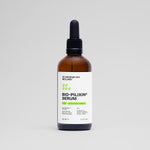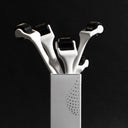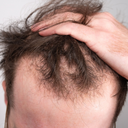Ever wondered if shaving increases hair growth? It’s a common question, especially when that stubbly feeling appears soon after a shave.
While it might feel like hair is growing back thicker or faster, the truth is, shaving doesn’t change how your hair grows.
Let’s cut through the confusion and dive into what really happens when you shave.
Table of content
Does shaving increase hair growth?
No, shaving doesn’t increase hair growth. It also doesn’t change the color or thickness of your hair. When you shave, you’re simply cutting the hair at the skin’s surface, which creates a blunt tip. As it grows back, this blunt tip may feel coarse or stubbly, making the hair seem thicker. But rest assured, the shaving process itself has no effect on how fast or thick your hair regrows.
That initial rough texture is just part of the hair’s natural growth phase. Once the hair grows longer, it feels softer again, just like before you shaved. So, while it might seem like shaving speeds things up, your hair growth rate stays exactly the same.
As your leading source for hair health information over the past 4 years, we never compromise on accuracy. When it comes to your health, you deserve information you can truly rely on - and earning your trust is our top priority.
Here's how Scandinavian Biolabs ensures every piece of content meets the highest standards of accuracy and integrity:
- Credentialed Experts: Our reviewers are actively practicing doctors and medical researchers
- Stringent Reviews: Content undergoes rigorous editing by subject specialists and review by a practicing doctor.
- Evidence-Based: We rely on well-established research from trusted scientific sources like peer-reviewed journals and health authorities.
- Full Transparency: Our editorial standards, writer credentials, reviewer credentials, correction process, and funding are all publicly documented.
- Independent Voice: While we do promote products, we operate in a vacuum to business operations. Our main goal is just an unwavering commitment to providing medically-sound guidance.
You can count on Scandinavian Biolabs to consistently deliver the trustworthy health information you deserve. Read our Editorial Standards.
Understanding the hair growth cycle
To really get why shaving doesn’t change your hair’s growth, it helps to understand the hair growth cycle. Body hair takes about a month to reach its full length, which is why it’s so much shorter than the hair on your head.
Hair starts its journey deep in the skin, forming in follicles with the help of proteins and blood. As it grows, it passes through sebaceous glands that coat it with sebum, a natural oil that keeps the hair moisturized. Once hair pushes through the skin’s surface, it’s technically dead.
When you shave, you’re only cutting this dead part of the hair at the skin’s surface. Since you’re not touching the follicle or hair beneath the skin, it’s impossible for shaving to affect how your hair looks, grows, or its overall thickness.
Does shaving make hair grow faster or thicker?

Shaving, whether it’s your legs, face, or anywhere else, doesn’t cause hair to grow faster or thicker. This myth likely exists because hair looks different when it starts growing back. Here’s why:
- Unshaven hair has a fine, tapered tip.
- When you shave, you’re left with the blunt, coarser base.
- As it grows out, it might look darker or thicker, but that’s just because it hasn’t been exposed to the elements like sun or soap yet.
Newly grown hair can be more noticeable, especially if you have lighter skin. The contrast can make those fresh hairs stand out more, but that’s all part of the natural regrowth process—not the shaving itself.
While shaving doesn’t change your hair’s texture or growth speed, improper techniques can lead to side effects like:
- Skin irritation
- Razor burn
- Ingrown hairs
- Pimples or blisters
- Itchy skin
How long does it take for hair to grow back?
Shaving doesn’t alter how fast your hair regrows, but you might still be curious about how long it takes. On average, hair grows about half an inch to one inch per month, but the exact speed depends on factors like the area of the body and your own hair growth rate.
You’ll notice quicker regrowth on areas like your scalp, where hair naturally grows faster. That’s why shaved heads seem to sprout hair back so soon. Other areas, like your legs or arms, take a little longer to pass through the stubble stage. It’s all about location!
There are some treatments, like a topical medication called eflornithine, that claim to slow hair growth, but they’re usually expensive and not very effective. So, if you’re thinking of trying them to prolong that smooth, just-shaved feeling, it might not be worth the hassle or cost.
Tips for shaving properly

A smooth shave isn’t just about grabbing a razor and going for it. Here’s a step-by-step guide to help you shave safely and avoid irritation:
- Wet your skin with warm water.
- Apply shaving gel or lotion to reduce friction.
- Shave in the direction your hair grows, not against it.
- Avoid pressing too hard on the razor.
- Use a fresh or disposable razor to prevent cuts and irritation.
- Rinse your skin with cool water post-shave.
- Finish with a moisturizer or aftershave to soothe the skin.
Face
When shaving your face, start by washing it with warm water and a gentle cleanser. Apply a shaving cream or gel, then shave in the direction your hair naturally grows. This will help reduce irritation and razor bumps.
Arms and legs
For arms and legs, exfoliating beforehand can help prevent ingrown hairs. Use a gentle scrub or loofah in the shower, then shave with a fresh razor, taking care around any curves to avoid nicks.
Armpits
Since armpit hair grows in multiple directions, shaving both with and against the hair growth is often necessary. You can also shave side-to-side to get a closer, smoother result.
Groin
Shaving the groin area requires extra care. Use a fresh razor and rinse it often since coarser hair can clog the blades quickly. This will help prevent irritation and those pesky ingrown hairs.
Does shaving stimulate hair follicles?
Shaving doesn’t stimulate your hair follicles. The act of shaving only affects the hair at the surface level, cutting off the visible part without impacting the follicle beneath your skin. Since the follicle controls the growth, texture, and color of your hair, shaving can’t influence how your hair grows back.
The only thing shaving might change is how your hair feels as it regrows, due to the blunt tip that forms after shaving. But your follicles stay the same, so the myth that shaving stimulates them is just that—a myth.
What are the real factors that influence hair growth?
While shaving doesn’t affect hair growth, several real factors do play a role. These include:
- Genetics: Your family history largely determines hair growth patterns.
- Hormones: Hormonal changes can affect the speed and thickness of hair growth.
- Diet: Nutrient deficiencies, like iron or biotin, can impact hair health.
- Age: Hair growth slows down naturally as we get older.
- Stress: High-stress levels can contribute to hair thinning and shedding.
A better approach for your overall hair growth

If you’re looking for a more effective way to promote hair growth, Bio-Pilixin® Serum offers a promising solution. Developed by experts, it’s designed to help reduce hair loss while encouraging the growth of new hair.
The key lies in its use of plant growth factors, which have been carefully developed using stem cell technology.
This innovative approach nourishes your follicles, creating an environment that supports healthier hair growth.
Bio-Pilixin® stands out because it’s drug-free, making it safe for daily use without altering your body’s metabolism or causing hormonal disruptions.
In clinical trials, 77% of participants saw reduced hair loss after just 45 days of use, and by 150 days, 73% had measurable improvements in hair density.
Unlike many pharmaceutical brands, Bio-Pilixin® works with your body, not against it.
Many users notice less hair loss in the shower within just a few weeks, which is often the first sign that the serum is working.
Since it’s effective on various types of hair loss—as long as follicles are still active—it’s a solid choice to consider, especially if you start treatment early in the hair loss process.
Plus, with a 150-day money-back guarantee, you can try Bio-Pilixin® without the worry of it not working. The earlier you begin, the better results you’re likely to see.
Conclusion
Shaving might not influence your hair growth, but plenty of other factors like genetics, hormones, and diet certainly do. If you’re serious about improving your hair health, Bio-Pilixin® Serum offers a gentle, science-backed approach that supports your follicles and encourages thicker, fuller hair over time.
Ready to try it out for yourself? Bio-Pilixin® Serum comes with a 150-day money-back guarantee, so you’ve got nothing to lose—except maybe some extra hair in the shower!
References:






